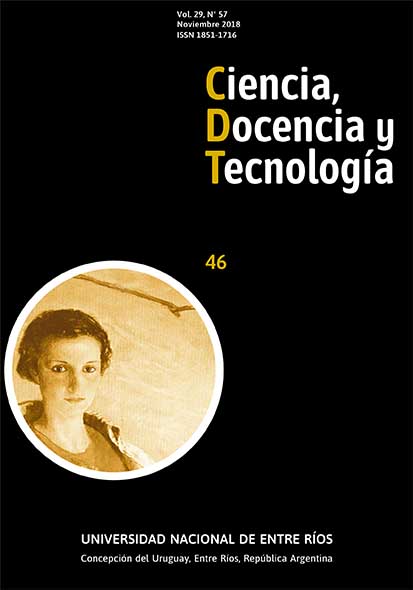Abstract
This article presents a brief history of the radar technology, from a sociotechnical approach. Thus, the analysis is centered in the cases of simultaneous development during the 1930’s and until the end of World War II in Germany, Japan, United Kingdom, United States, the ex ussr. The concept of co-creation is used in order to explain how technology and society were mutually shaped and, therefore, different socio-technical styles, linked to the radar, arose. The article is based on secondary sources and is a contribution to the history of a technology about which there is little material in Spanish.
References
AUSTIN, B. A., (1992). Radar in World War II. The South African Contribution. Engineering Science and Education Journal, 1(3), pp. 121-130.
BEYERCHEN, A., (1994). On strategic goals as perceptual filters: interwar responses to the potential of radar in Germany, the UK and the US. en: O. BLUMTRITT, H. PETZOLD y W. ASPRAY, (eds.). Tracking the radar history. Piscataway, New Jersey: IEEE - Rutgers Center for the History of Electrical Engineering and Deutsches Museum.
BIJKER, W. E., (2006). Why and How Technology matters?. En: GOODIN, R. y TILLY, C. (eds.). Oxford Handbook of Contextual Political Analysis. s.l.:Oxford University Press, pp. 681-702.
BIJKER, W. E., (2013 [1987]). La construcción social de la baquelita: hacia una teoría de la invención. En: THOMAS, H. y BUCH, A. (Coords.). Actos, actores y artefactos. Sociología de la tecnología. Quilmes: Universidad Nacional de Quilmes, pp. 63-100.
BIJKER, W. y PINCH, T., (2013 [1987]). La construcción social de hechos y artefactos: o acerca de cómo la sociología de la ciencia y la sociología de la tecnología pueden beneficiarse mutuamente. En: THOMAS, H. y BUCH, A. (Coords.). Actos, actores y artefactos. Sociología de la Tecnología. Quilmes: Universidad Nacional de Quilmes, pp. 19-62.
BROWN, L., (1999). A radar history of World War II - Technical and military imperatives. Bristol: Institute of Physics Publishing.
CHERNYAK, V. S. e Immoreev, I. Y., (2009). A brief history of radar in the Soviet Union and Russia. IEEE AyE Systems Magazine, Volume Sept 2009 INSERT, pp. B1-B31.
GOEBEL, G., (2013). The Wizard War: WW2 y The Origins Of Radar. [Online]
Disponible en: < www.vectorsite.net/ttwiz.html >
Julio 2013].
GUARNIERI, M. (2010). The early history of radar. IEEE Industrial Electronics Magazine, Sep 2010, 36-38; 42.
JAMES, R. J., 1989. A history of radar. IEE Review, Volume Oct-1989, pp. 343 - 349.
JASANOFF, S., (2004). Ordering knowledge, ordering society. En: JASANOFF, S. (Ed.) States of knowledge. The co-production of science and social order. New York: Routledge, pp. 13-44.
KAISER, W., (1994). The development of electron tubes and of radar technology: the relationship of science and technology. En: O. BLUMTRITT, H. PETZOLD y W. ASPRAY, (eds.). Tracking the History of Radar. Piscataway, New Jersey: IEEE - Rutgers Center for the History of Electrical Engineering and Deutsches Museum.
KERN, U., (1994). Review Concerning the History of German Radar Technology up to 1945. En: O. BLUMTRITT, H. PETZOLD y W. ASPRAY, (eds.). Tracking the History or Radar. Piscataway: IEEE - Rutgers Center for the History of Electrical Engineering and Deutsches Museum, pp. 171-183.
KOSTENKO, A., Nosich, A. I. y Tishchenko, I. A., (2001). Development of the first Soviet three-coordinate L-band pulsed radar in Kharkov before WWII. IEEE Antennas and Propagation Magazine, 43(3), pp. 29-48.
KÜMMRITZ, H., (1994). On the development of radar technologies in Germany up to 1945. En: O. BLUMTRITT, H. PETZOLD y W. ASPRAY, (eds.). Tracking the History or Radar. Piscataway: IEEE - Rutgers Center for the History of Electrical Engineering and Deutsches Museum, pp. 25-46.
QUIROGA, J. M. y Aguiar, D., 2016. Abriendo la “caja negra” del radar. Las políticas de radarización para uso civil y de defensa en Argentina entre 1948 y 2004.. H-Industri@, 10(19), pp. 71-100.
SINNOT, D. H., (2005). Defense Radar Development in Australia: 1939 to the Present. IEEE AyE Systems Magazine, pp. 27-31.
SÜSSKIND, C., (1994). Radar as case study in simultaneous invention. En: O. BLUMTRITT, H. PETZOLD y W. ASPRAY, (eds.). Tracking the History of Radar. Piscataway, New Jersey: IEEE - Rutgers Center for the History of Electrical Engineering and Deutsches Museum.
SWORDS, S. S., (2008). Technical history of the beginnings of radar (History of technology series no. 6). Londres: Institution of Engineering and Technology.
THUMM, M., (2001). Historical German contributions to physics and applications of electromagnetic oscillations and waves. Nizhny Novgorod, Russia, Proc. Int. Conf. on Progress in Nonlinear Science, pp. 623-643.
TOMLIN, D. H., (1988). From searchlights to radar: the history of anti-aircraft and coastal defense development (1917-1953). s.l., s.n.
WILKINSON, R. I., (1946). Short survey on Japanese radar. Electrical Engineering, Volume Aug-Sept 1946, pp. 370-377.
The authors retain the copyright and grant the journal the right to be the first publication of the work, as well as licensing it under a Creative Commons Attribution License that allows others to share the work with an acknowledgment of the authorship of the work and publication initial in this magazine. All content is published under the Creative Commons 4.0 international license: Attribution-Non-Commercial-Share Alike.

